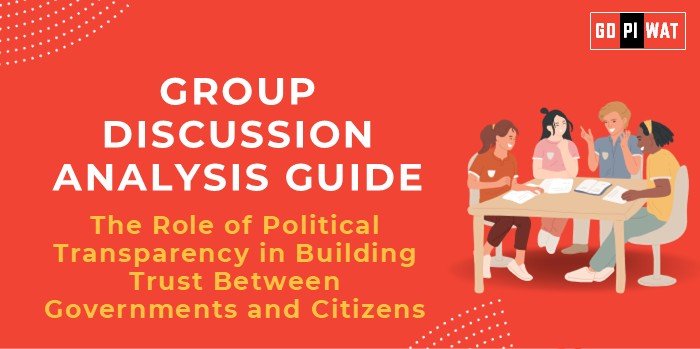📋 Group Discussion Analysis Guide: The Role of Political Transparency in Building Trust Between Governments and Citizens
🌟 Introduction to Political Transparency
Opening Context: Around the world, political transparency has emerged as a cornerstone of governance, integral to fostering trust between governments and citizens. It is particularly relevant in democracies where accountability to the electorate forms the basis of legitimacy.
Topic Background: The concept of political transparency emphasizes open communication, accessible information, and responsive decision-making by governments. Key global milestones include the Open Government Partnership (OGP) established in 2011 and the global trend of Right to Information (RTI) laws.
📊 Quick Facts and Key Statistics
- 🌍 Countries with RTI Laws: 136 nations globally; India introduced its RTI Act in 2005, empowering citizens to seek information on public authorities.
- 📈 Transparency International Corruption Perception Index 2023: Denmark ranks #1; India’s ranking improved to 85/180.
- 💬 Public Trust Metrics: Trust in government increases by 20% in nations with high transparency (Edelman Trust Barometer 2023).
- 💻 Digital Governance Growth: Over 80 countries have adopted e-governance frameworks to improve transparency.
👥 Stakeholders and Their Roles
- 📜 Government Bodies: Enact and enforce transparency laws; uphold accountability.
- 📰 Media and NGOs: Monitor and report governance issues, ensuring public awareness.
- 🧑🤝🧑 Citizens: Engage actively by leveraging transparency laws.
- 🌍 International Organizations: Advocate for global transparency norms and frameworks, e.g., OGP, UNDP.
✅ Achievements and Challenges
🏆 Achievements:
- 📜 Right to Information Acts: Empower citizens in India, Mexico, and Sweden to access critical government data.
- 💻 E-Governance Platforms: Nations like Estonia have digitized over 99% of government services, enhancing transparency.
- 🕵️♀️ Corruption Control: Increased transparency has led to significant declines in corruption across Nordic countries.
⚠️ Challenges:
- 🕶️ Opaque Decision-Making: Lack of public disclosure in authoritarian regimes undermines trust.
- 🌐 Technological Barriers: Digital divides hinder e-governance adoption in developing nations.
- ❌ Misinformation Threats: Transparency can sometimes lead to selective or distorted information circulation.
🌍 Global Comparisons
- 🇪🇪 Estonia: Pioneering e-governance with blockchain-backed transparency.
- 🇮🇳 India: Progress with RTI but limited by bureaucratic delays and low digital literacy.
📖 Case Studies:
- 🇮🇳 India: Effective use of RTI in exposing scams (e.g., 2G Spectrum Case).
- 🇩🇰 Nordics: High transparency correlates with lower corruption levels.
📌 Structured Arguments for Discussion
- 🔹 Supporting Stance: “Transparency fosters accountability, empowering citizens to hold governments responsible.”
- 🔹 Opposing Stance: “Excessive transparency can deter candid internal deliberations in governance.”
- 🔹 Balanced Perspective: “While transparency builds trust, it must be balanced with national security and privacy concerns.”
🔍 Effective Discussion Approaches
- 📈 Opening Approaches:
- “Transparency International’s findings show nations with greater openness witness higher citizen trust—let’s discuss how this applies globally.”
- “The rise of e-governance as a tool for transparency highlights both opportunities and challenges.”
- 🔄 Counter-Argument Handling:
- Reference specific case studies (e.g., Estonia, India) to counter generalizations.
📈 Strategic Analysis: Strengths and Weaknesses
- ✅ Strengths: Enhances accountability, curtails corruption, fosters trust.
- ⚠️ Weaknesses: Risks misuse of sensitive information, resource-intensive implementation.
- 🌟 Opportunities: AI and blockchain to revolutionize transparency mechanisms.
- ⚡ Threats: Cybersecurity risks, misinformation spread.
🎓 Connecting with B-School Applications
- 💡 Real-World Applications: Transparency in governance models for operational strategy, ethics in management.
- 💬 Sample Interview Questions:
- “How does transparency impact corporate governance?”
- “Discuss examples where transparency has reduced corruption.”
- 📘 Insights for Students: Understanding transparency fosters ethical leadership and decision-making skills.


